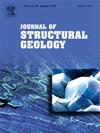A long history of ductile and brittle deformation of Eastern Pyrenees fault zones: coupling 40Ar/39Ar geochronology, chlorite geothermometry and structural observation
IF 2.9
2区 地球科学
Q2 GEOSCIENCES, MULTIDISCIPLINARY
引用次数: 0
Abstract
In orogenic settings, fault networks accommodate crustal deformation during the evolution of mountain ranges. Fault zones exhibit multiphase ductile and brittle activity, complicating their interpretation. Dating deformation in orogenic basement remains a challenge. In this study, we conducted structural and microstructural observations, coupled with 40Ar/39Ar dating on encapsulated mineral fractions and chlorite thermometry, on major fault zones in the Eastern Pyrenees. To overcome the presence of K-feldspar within fault gouge, a major issue for fault gouge argon dating, we present a method to estimate the contribution of two mixed K-rich phases from 40Ar/39Ar step heating. This method provides limit or maximum age for the deformation recorded by fault gouges in which illite polytypes are mixed with K-feldspar. Our results reveal a ductile-to-brittle transition between 40 and 35 Ma (Priabonian-Bartonian), characterized by 2M1 muscovite and evidence of strike-slip movement along the Py NE-SW fault and NW-SE secondary faults. The Py fault gouge contains muscovite formed at temperatures exceeding 200–250 °C. In the Têt NE-SW fault gouge, the coexistence of 2M1 and 1M illite polytypes suggests late-stage crystallization of 1M illite at 22.1 ± 1.4 Ma, at temperatures between 100 and 150 °C, as determined by chlorite thermometry. These findings confirm significant normal faulting activity on the Têt fault during the Oligo-Miocene, consistent with published low-temperature thermochronology data indicating early exhumation of the Canigou massif relative to the Carança massif, facilitated by normal displacement along the Py fault, and a later exhumation of both massifs in relation to the Têt normal fault activity.
东比利牛斯断裂带韧性和脆性变形的悠久历史:40Ar/39Ar年代学、绿泥石地热测量和构造观测的耦合
在造山带中,断层网在山脉演化过程中容纳了地壳变形。断裂带表现出多相韧性和脆性活动,使其解释复杂化。造山带形变测年仍然是一个挑战。在这项研究中,我们对东比利牛斯山脉的主要断裂带进行了结构和微观结构观察,并对包裹矿物组分进行了40Ar/39Ar测年和绿泥石测温。为了克服断层泥中钾长石的存在,这是断层泥氩定年的一个主要问题,我们提出了一种估算40Ar/39Ar阶梯加热两种混合富k相贡献的方法。这种方法为断层泥所记录的伊利石多型与钾长石混合的变形提供了极限或最大年龄。结果表明,在40 ~ 35 Ma (Priabonian-Bartonian)之间存在韧性-脆性转变,以2M1白云母为特征,并有沿Py NE-SW断裂和NW-SE次断裂的走滑运动证据。Py断层泥含有在温度超过200-250℃时形成的白云母。在Têt NE-SW断层泥中,2M1和1M伊利石多型共存,表明1M伊利石在22.1±1.4 Ma的温度下,在100 ~ 150℃之间结晶。这些发现证实了Têt断层在渐新世至中新世期间有明显的正断层活动,与已发表的低温热年代学数据一致,表明Canigou地块相对于carana地块的早期发掘,是由于沿Py断层的正位移,以及相对于Têt正断层活动的较晚两个地块的发掘。
本文章由计算机程序翻译,如有差异,请以英文原文为准。
求助全文
约1分钟内获得全文
求助全文
来源期刊

Journal of Structural Geology
地学-地球科学综合
CiteScore
6.00
自引率
19.40%
发文量
192
审稿时长
15.7 weeks
期刊介绍:
The Journal of Structural Geology publishes process-oriented investigations about structural geology using appropriate combinations of analog and digital field data, seismic reflection data, satellite-derived data, geometric analysis, kinematic analysis, laboratory experiments, computer visualizations, and analogue or numerical modelling on all scales. Contributions are encouraged to draw perspectives from rheology, rock mechanics, geophysics,metamorphism, sedimentology, petroleum geology, economic geology, geodynamics, planetary geology, tectonics and neotectonics to provide a more powerful understanding of deformation processes and systems. Given the visual nature of the discipline, supplementary materials that portray the data and analysis in 3-D or quasi 3-D manners, including the use of videos, and/or graphical abstracts can significantly strengthen the impact of contributions.
 求助内容:
求助内容: 应助结果提醒方式:
应助结果提醒方式:


